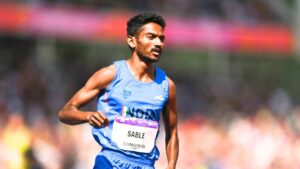At the Delhi State Athletics Championships held at the JLN Stadium, the glaring cracks in India’s athletics scene were laid bare for all to see. Athletes, once regarded as the embodiment of discipline and dedication, resorted to a shocking display of indiscipline. Performance-enhancing drugs, the bane of modern sports, took centre stage, leaving a stain on the country’s athletic reputation.
According to a report in the Indian Express, the Delhi State Athletics Championships turned into a farce. In the men’s 100m final, a solitary athlete stood on the starting line, while others chose to flee the venue or simply refused to compete.
Also Read: Asian Games 2023: A Glimpse of Power and Potential Indian Athletics Squad
In a bizarre turn of events, a steeplechase runner continued running even after crossing the finish line, desperately trying to evade a mandatory dope test. To add insult to injury, the medal winners absconded from the award ceremony, all in an effort to avoid providing samples for drug testing. Shockingly, the competition venue’s bathrooms were littered with empty packets of Recombinant Human Erythropoietin (EPO) injection, a drug typically used to treat anaemia.
"Preparations" for the Delhi State Athletics meet in full swing. Video from JLN stadium that also houses the National Anti-Doping office.
🎥 Clip sent by a coach. pic.twitter.com/W7RivSDJ7r— Andrew (@AndrewAmsan) September 23, 2023
While this incident might not be an isolated case, it underscores a grave issue that threatens the very foundation of India’s future in athletics. The rampant use of performance-enhancing drugs not only tarnishes the image of our athletes but also raises questions about the integrity of our sporting institutions.
Reason For India’s Athletics Dilemma
In the realm of sprinting, India has long been in the shadows of global giants like Usain Bolt and Yohan Blake. The elusive sub-10-second barrier in men’s 100m and the sub-11-second mark for women seem like distant dreams. But why does India consistently lag behind in athletics, with only a handful of exceptions? While myriad factors contribute to this quandary, one glaring issue looms large – the absence of a robust athletics culture and a startling lack of awareness among our athletes.
The drug menace in Indian athletics is not a recent development. It has been a persistent issue, lurking beneath the surface and occasionally rearing its ugly head. Athletes resort to doping for various reasons, including the pressure to perform, the allure of fame and fortune, and a lack of proper guidance.
Only one participant turned up today for the 100m finals at the Delhi State Championships, fearing dope tests. For a more detailed story read tomorrow's Express https://t.co/AimeKjmnFA pic.twitter.com/mPeAixgIlB
— Andrew (@AndrewAmsan) September 26, 2023
The consequences of doping in sports are far-reaching and devastating. Beyond tarnishing the reputation of athletes and the nation, doping poses significant health risks to those who succumb to its allure. Athletes who resort to performance-enhancing drugs often experience severe physical and psychological repercussions. Furthermore, the use of such substances undermines the very essence of fair competition and robs clean athletes of their rightful achievements.
To extricate Indian athletics from the clutches of the drug menace, a multifaceted approach is imperative. Here are some key steps that need to be taken to address this pressing issue:
1. Education and Awareness
The first and most crucial step is to educate athletes about the dangers of doping. Athletes should be made aware of the long-term health risks and the severe consequences of getting caught. Workshops, seminars, and awareness campaigns should be organized at all levels of athletics to instil a sense of responsibility and ethics among athletes.
2. Stringent Anti-Doping Measures
Indian sports authorities must adopt a zero-tolerance policy towards doping. Stringent anti-doping measures, including regular and surprise testing, should be implemented. The penalties for doping violations should be severe enough to serve as a strong deterrent.
3. Support Systems
Athletes should have access to comprehensive support systems that address their physical, mental, and emotional well-being. Proper coaching, nutrition, and sports science facilities should be made available to help athletes achieve their full potential without resorting to doping.
4. Role Models and Mentors
Establishing role models and mentors who have excelled in clean sports is essential. These figures can inspire and guide young athletes, showing them that success can be achieved through hard work, dedication, and integrity.
5. Ethical Leadership
Sports organizations must lead by example. They should uphold the highest ethical standards and promote a culture of fairness, transparency, and integrity. Leaders in sports should be committed to eradicating doping from its roots.
The recent debacle at the Delhi State Athletics Championships serves as a stark reminder of the uphill battle India faces in its quest for sporting excellence. While the road ahead may be arduous, it is not insurmountable. With unwavering commitment, education, and a collective effort, India can rise above the drug menace and usher in an era of clean and competitive athletics.





